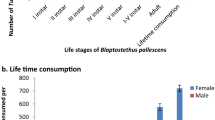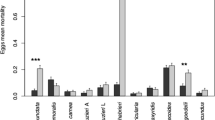Abstract
Pre-release techniques aim to increase the searching by the predators for their prey. Keeping bug predators for periods without food before their release can increase the search ability of these insects. However, this practice can increase the cannibalism during mass rearing. Brontocoris tabidus (Signoret) and Podisus nigrispinus (Dallas) (Heteroptera: Pentatomidae) were kept for 12, 24, 36 and 48 h without food or with only Eucalyptus cloeziana plants in order to verify the occurrence of cannibalism on adults and eggs. Insects kept for periods longer than 24 h showed higher cannibalism on adults and eggs and the presence of a E. cloeziana plant decreased the cannibalism during all the treatment periods. These predators preferred to attack first the eggs rather than the adults, probably because of the inability of the former to avoid predation. The pre-release period should not exceed 24 h and plants must be provided to the predators in order to reduce the occurrence of cannibalism and increase the predatory capacity of these natural enemies.


Similar content being viewed by others
References
Begon, M., Townsend, C. A., & Harper, J. L. (2005). Ecology: from individuals to ecosystems (4th ed.). Hoboken, NJ, USA: Wiley-Blackwell.
Bell, W. J. (1990). Searching behavior patterns in insects. Annual Review of Entomology, 35, 447–467.
Bernays, E. A., Bright, K. L., Gonzalez, N., & Angel, J. (1994). Dietary mixing in a generalist herbivore: tests of two hypotheses. Ecology, 75, 1997–2006.
Crum, D. A., Weiser, L. A., & Stamp, N. E. (1998). Effects of prey scarcity and plant material as a dietary supplement on an insect predator. Oikos, 81, 549–557.
De Clercq, P., & Degheele, D. (1992). Influence of feeding interval on reproduction and longevity of Podisus sagitta (Heteroptera: Pentatomidae). Entomophaga, 37, 583–590.
Evangelista, W. S., Jr., Gondim, M. G. C., Jr., Torres, J. B., & Marques, E. J. (2004). Fitofagia de Podisus nigrispinus em algodoeiro e plantas daninhas. Pesquisa Agropecuária Brasileira, 39, 413–420.
Ferreira, J. A. M., Zanuncio, J. C., Torres, J. B., & Molina-Rugama, A. J. (2008). Predatory behaviour of Podisus nigrispinus (Heteroptera: Pentatomidae) on different densities of Anticarsia gemmatalis (Lepidoptera: Noctuidae) larvae. Biocontrol Science and Technology, 18, 711–719.
Frazer, B. D., & Gill, B. (1981). Hunger, movement, and predation of Coccinella californica on pea aphids in the laboratory and in the field. Canadian Entomologist, 113, 1025–1033.
Grosman, A. H., van Breemen, M., Holtz, A. M., Pallini, A., Molina-Rugama, A. J., Pengel, H., et al. (2005). Searching behaviour of an omnivorous predator for novel and native host plants of its herbivores: a study on arthropod colonization of eucalyptus in Brazil. Entomologia Experimentalis et Applicata, 116, 135–142.
Guglielmo, C. G., Karasov, W. H., & Jakubas, W. J. (1996). Nutritional costs of a plant secondary metabolite explain selective foraging by Ruffed Grouse. Ecology, 77, 1103–1115.
Holtz, A. M., Zanuncio, J. C., Oliveira, C. L., Pratissoli, D., Marinho, J. S., & Vianna, U. R. (2007). Potencial reprodutivo e de sobrevivência de Podisus nigrispinus Dallas (Heteroptera: Pentatomidae) sobre Thyrinteina arnobia Stoll (Lepidoptera: Geometridae) e Tenebrio molitor L. (Coleoptera: Tenebrionidae). Floresta, 37, 63–70.
Juliano, S. A. (1986). Food limitation of reproduction and survival for populations of Brachinus (Coleoptera: Carabidae). Ecology, 67, 1036–1045.
Jusselino-Filho, P., Zanuncio, J. C., Fragoso, D. B., Serrão, J. E., & Lacerda, M. C. (2003). Biology of Brontocoris tabidus (Heteroptera: Pentatomidae) fed with Musca domestica (Diptera: Muscidae) larvae. Brazilian Journal of Biology, 63, 463–468.
Kuriwada, T., Kumano, N., Shiromoto, K., & Haraguchi, D. (2009). High population density and egg cannibalism reduces the efficiency of mass-rearing in Euscepes postfasciatus (Coleoptera: Curculionidae). Florida Entomologist, 92, 221–228.
Lambert, A. M. (2007). Effects of prey availability, facultative plant feeding, and plant defenses on a generalist insect predator. Arthropod-Plant Interactions, 1, 167–173.
Laycock, A., Camm, E., Van Laerhoven, S., & Gillespie, D. (2006). Cannibalism in a zoophytophagous omnivore is mediated by prey availability and plant substrate. Journal of Insect Behavior, 19, 219–229.
Lemos, W. P., Serrão, J. E., Zanuncio, J. C., Lacerda, M. C., Zanuncio, V. V., & Ribeiro, R. C. (2009). Body weight and protein content in the haemolymph of females of the zoophytophagous predator Brontocoris tabidus (Heteroptera: Pentatomidae) with different diets and ages. Journal of Plant Diseases and Protection, 116, 218–222.
Lemos, W. P., Zanuncio, J. C., Ramalho, F. S., Zanuncio, V. V., & Serrão, J. E. (2010). Herbivory affects ovarian development in the zoophytophagous predator Brontocoris tabidus (Heteroptera: Pentatomidae). Journal of Pest Science, 83, 69–76.
Lemos, W. P., Zanuncio, J. C., & Serrão, J. E. (2005). Attack behavior of Podisus rostralis (Heteroptera: Pentatomidae) adults on caterpillars of Bombyx mori (Lepidoptera: Bombycidae). Brazilian Archives of Biology and Technology, 48, 975–981.
Lenski, R. E. (1984). Food limitation and competition: a field experiment with two Carabus species. Journal of Animal Ecology, 53, 203–216.
Medeiros, R. S., Ramalho, F. S., Lemos, W. P., & Zanuncio, J. C. (2000). Age-dependent fecundity and life-fertility tables for Podisus nigrispinus (Dallas) (Heteteroptera: Pentatomidae). Journal of Applied Entomology, 124, 319–324.
Michaud, J. P. (2003). A comparative study of larval cannibalism in three species of ladybird. Ecological Entomology, 28, 92–101.
Molina-Rugama, A., Zanuncio, J. C., & Oliveira, M. L. R. (1998a). Reproductive strategy of Podisus rostralis (Stål) (Heteroptera: Pentatomidae) females under different feeding intervals. Biocontrol Science and Technology, 8, 583–588.
Molina-Rugama, A. J., Zanuncio, J. C., Pratissoli, D., & Cruz, I. (1998b). Efeito do intervalo de alimentação na reprodução e na longevidade do predador Podisus nigrispinus (Dallas) (Heteroptera: Pentatomidae). Anais da Sociedade Entomológica do Brasil, 27, 77–84.
Moreira, L. A., Zanuncio, J. C., & Molina-Rugama, A. J. (1998). Dados biológicos de Podisus nigrispinus (Dallas) alimentado com a lagarta do maracujazeiro Dione juno juno (Cramer). Anais da Sociedade Entomológica do Brasil, 27, 645–647.
Mourão, S. A., Zanuncio, J. C., Molina-Rugama, A. J., Vilela, E. F., & Lacerda, M. C. (2003). Efeito da escassez de presa na sobrevivência e reprodução do predador Supputius cincticeps (Stål) (Heteroptera: Pentatomidae). Neotropical Entomology, 32, 469–473.
Oliveira, J. E. M., Torres, J. B., Carrano-Moreira, A. F., & Barros, R. (2002). Efeito das plantas do algodoeiro e do tomateiro, como complemento alimentar, no desenvolvimento e na reprodução do predador Podisus nigrispinus (Dallas) (Heteroptera: Pentatomidae). Neotropical Entomology, 31(1): 101–108.
Oliveira, H., Zanuncio, J. C., & Santos, G. P. (1999). Nutrición de Brontocoris tabidus (Signoret) (Heteroptera: Pentatomidae) alimentado en larvas de Tenebrio molitor L. (Coleoptera: Tenebrionidae) o Bombyx mori L. (Lepidoptera: Bombycidae). AgroCiência, 15, 75–80.
O’Neil, R. J., & Wiedenmann, R. N. (1990). Body weight of Podisus maculiventris (Say) under various feeding regimens. Canadian Entomologist, 122, 285–294.
Parra, J. R., Botelho, P. S. M., Ferreira, B. S. C., & Bento, J. M. S. (2002). Controle biológico no Brasil: parasitóides e predadores. Sao Paulo, Brazil: Editora Manole.
Pearson, D. L., & Knisley, C. B. (1985). Evidence for food as a limiting resource in the life cycle of tiger beetles (Coleoptera: Cicindelidae). Oikos, 45, 161–168.
Pereira, A. I. A., Ramalho, F. S., Malaquia, J. B., Bandeira, C. M., Silva, J. P. S., & Zanuncio, J. C. (2008). Density of Alabama argillacea larvae affects food extraction by females of Podisus nigrispinus. Phytoparasitica, 36, 84–94.
Pires, E. M., Pinto, R., Lacerda, M. C., Zanuncio, J. C., & Fialho, M. C. Q. (2006). Potencial reprodutivo horário do predador de lagartas desfolhadoras de eucalipto Podisus nigrispinus (Heteroptera: Pentatomidae). Revista Árvore, 31, 1039–1044.
Pires, E. M., Pinto, R., Soares, M. A., Santos, G. P., Zanuncio, T. V., & Zanuncio, J. C. (2009). Produção de percevejos predadores. Visconde do Rio Branco, MG, Brazil: Gráfica Suprema Editora.
Polis, G. A. (1981). The evolution and dynamics of intraspecific predation. Annual Review of Ecology and Systematics, 12, 225–251.
Pratissoli, D., Thuler, R. T., Andrade, G. S., Zanotti, L. C. M., & Silva, A. F. (2005a). Estimativa de Trichogramma pretiosum para controle de Tuta absoluta em tomateiro estaqueado. Pesquisa Agropecuária Brasileira, 40, 715–718.
Pratissoli, D., Vianna, U. R., Zago, H. B., & Pastori, P. L. (2005b). Capacidade de dispersão de Trichogramma em tomateiro estaqueado. Pesquisa Agropecuária Brasileira, 40, 613–616.
Ramalho, F. S., Mezzomo, J., Lemos, W. P., Bandeira, C. M., Malaquias, J. B., Silva, J. P. S., et al. (2008). Reproductive strategy of Podisus nigrispinus females under different feeding intervals. Phytoparasitica, 36, 30–37.
Ramalho, F. S., Mezzomo, J., Lemos, W. P., & Zanuncio, J. C. (2004). Reproductive behaviour and longevity of Podisus nigrispinus (Heteroptera: Pentatomidae) in different feeding intervals. Journal of Applied Entomology, 56, 1523–1527.
Saavedra, J. L. D., Zanuncio, J. C., Zanuncio, T. V., & Cantor, F. (1998). Dieta artificial con carne de res, hojas de mora (Morus alba), sales de Wesson y yema de huevo de gallina para Podisus nigrispinus (Hemiptera: Pentatomidae). Revista Colombiana de Entomologia, 24, 13–16.
SAEG. (2007). Sistema para Análises Estatísticas, Versão 9.1. Viçosa, Brazil: Fundação Arthur Bernardes—UFV.
Sinia, A., Roitberg, B., McGregor, R. R., & Gillespie, D. R. (2004). Prey feeding increases water stress in the omnivorous predator Dicyphus hesperus. Entomologia Experimentalis et Applicata, 110, 243–248.
Torres, J. B., Evangelista, W. S., Jr., Barras, R., & Guedes, R. N. C. (2002). Dispersal of Podisus nigrispinus (Het., Pentatomidae) nymphs preying on tomato leafminer: effect of predator release time, density and satiation level. Journal of Applied Entomology, 126, 326–332.
Vacari, A. M., Otuka, A. K., & Bortoli, S. A. (2007). Desenvolvimento de Podisus nigrispinus (Dallas, 1851) (Hemiptera: Pentatomidae) alimentado com lagartas de Diatraea saccharalis (Fabricius, 1794) (Lepidoptera: Crambidae). Arquivos do Instituto Biológico, 74, 259–265.
Zanuncio, J. C., Alves, J. B., Zanuncio, T. V., & Garcia, J. F. (1994). Hemipterous predators of eucalypt defoliator caterpillars. Forest Ecology and Management, 65, 65–73.
Zanuncio, J. C., Lemos, W. P., Lacerda, M. C., Zanuncio, T. V., Serrão, J. E., & Bauce, E. (2006). Age-dependent fecundity and fertility life tables of the predator Brontocoris tabidus (Heteroptera: Pentatomidae) under field conditions. Journal of Economic Entomology, 99, 401–407.
Zanuncio, J. C., Molina-Rugama, A. J., Serrão, J. E., & Pratissoli, D. (2001). Nymphal development and reproduction of Podisus nigrispinus (Heteroptera: Pentatomidae) fed with combinations of Tenebrio molitor (Coleoptera: Tenebrionidae) pupae and Musca domestica (Diptera: Muscidae) larvae. Biocontrol Science and Technology, 11, 331–337.
Zanuncio, J. C., Saavedra, J. L. D., Oliveira, H. N., Degheele, D., & De Clercq, P. (1996). Development of the predatory stinkbug Brontocoris tabidus (Signoret) (Heteroptera: Pentatomidae) on different proportions of an artificial diet and pupae of Tenebrio molitor L. (Coleoptera: Tenebrionidae). Biocontrol Science and Technology, 6, 619–625.
Zanuncio, J. C., Silva, C. A. D., Rodrigues, E., Pereira, F. F., Ramalho, F. S., & Serrão, J. E. (2008a). Predation rate of Spodoptera frugiperda (Lepidoptera: Noctuidae) larvae with and without defense by Podisus nigrispinus (Heteroptera: Pentatomidae). Brazilian Archives of Biology and Technology, 51, 125–129.
Zanuncio, J. C., Zanuncio, T. V., Guedes, R. N. C., & Ramalho, F. S. (2000). Effect of feeding on three Eucalyptus species on the development of Brontocoris tabidus (Heteroptera: Pentatomidae) fed with Tenebrio molitor (Coleoptera: Tenebrionidae). Biocontrol Science and Technology, 10, 443–450.
Zanuncio, T. V., Gomides, C. H. F., Vargas, P. S. R., Souza, J. M., Ramalho, F. S., Serrão, J. E., & Zanuncio, J. C. (2008b). Utilização de mudas de Eucalyptus grandis melhora a criação do predador Brontocoris tabidus (Het.: Pentatomidae) em laboratório. Arquivos do Instituto Biológico, 75(2): 167–171.
Acknowledgments
We acknowledge with thanks the help of “Conselho Nacional de Desenvolvimento Científico e Tecnológico” (CNPq) and of Professor Roberta Martins Nogueira, Federal University of Mato Grosso.
Author information
Authors and Affiliations
Corresponding author
Rights and permissions
About this article
Cite this article
Pires, E.M., Zanuncio, J.C. & Serrão, J.E. Cannibalism of Brontocoris tabidus and Podisus nigrispinus during periods of pre-release without food or fed with Eucalyptus cloeziana plants. Phytoparasitica 39, 27–34 (2011). https://doi.org/10.1007/s12600-010-0132-6
Received:
Accepted:
Published:
Issue Date:
DOI: https://doi.org/10.1007/s12600-010-0132-6




